Abstract
The results of bronchography in 96 consecutive patients investigated for haemoptysis at Papworth Hospital from 1975 to 1983 were reviewed. None of the patients included in this study gave a history suggestive of bronchiectasis and neither chest radiography nor fibreoptic bronchoscopy had shown a cause for the bleeding. Bronchography was performed through the fibreoptic bronchoscope and all included in the study showed both lungs adequately. The chest radiographic appearances were compared with the bronchographic findings. Seven of 12 patients with appearances suggesting old fibrosis showed bronchiectasis, as did eight of 10 with radiographic appearances suggestive of bronchiectasis. Eleven out of 74 patients with normal chest radiographs, however, also showed bronchiectasis. This group of 11 was compared with the other 63 but no clinical feature was found to be significantly associated with the presence of bronchiectasis. Although bronchography is now rarely used in the investigation of haemoptysis, this high yield (15%) of bronchiectasis indicates that its use should be reappraised. Follow up of the patients indicated that bronchography was not reliable at diagnosing peripheral bronchial carcinomas, which became evident later in two cases, and that asthma was present in 15 (24%) of the 63 patients with both normal chest radiographs and normal bronchograms.
Full text
PDF


Selected References
These references are in PubMed. This may not be the complete list of references from this article.
- Flower C. D., Shneerson J. M. Bronchography via the fibreoptic bronchoscope. Thorax. 1984 Apr;39(4):260–263. doi: 10.1136/thx.39.4.260. [DOI] [PMC free article] [PubMed] [Google Scholar]
- Forrest J. V., Sagel S. S., Omell G. H. Bronchography in patients with hemoptysis. AJR Am J Roentgenol. 1976 Mar;126(3):597–600. doi: 10.2214/ajr.126.3.597. [DOI] [PubMed] [Google Scholar]


